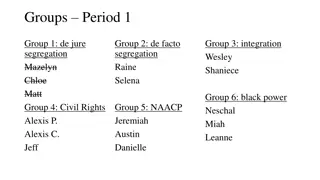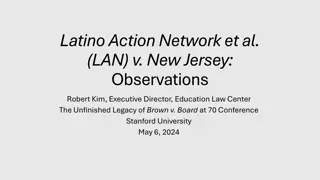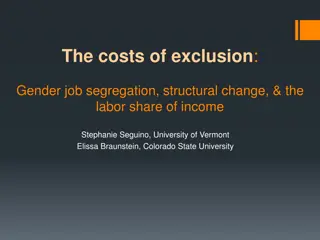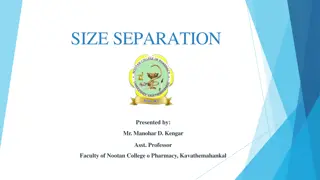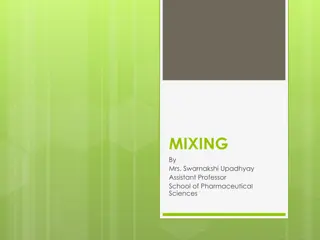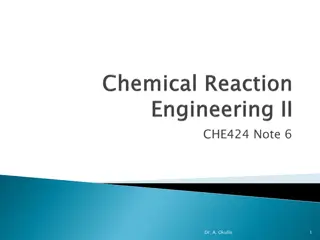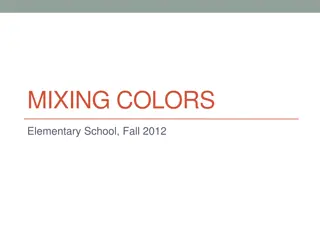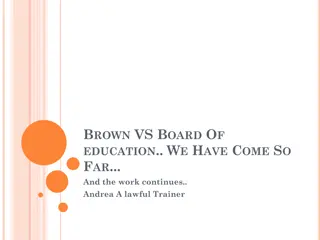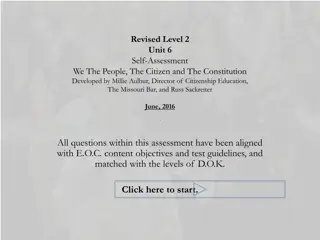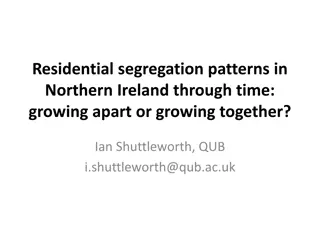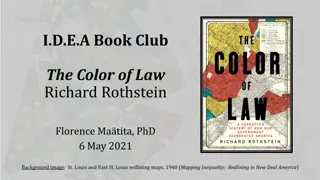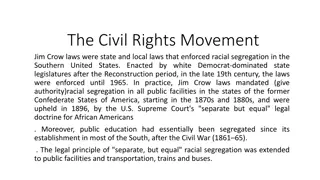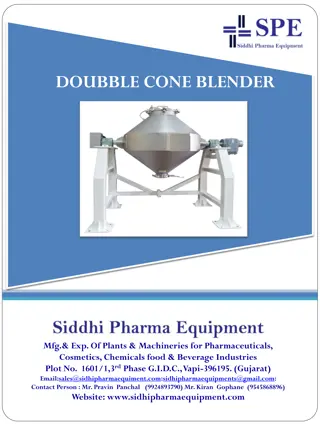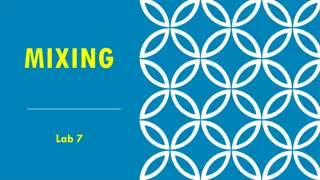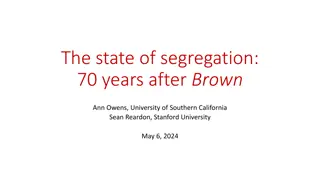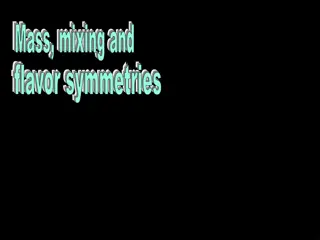Mixing and Segregation in Unit Operations
Mixing and segregation are vital concepts in unit operations, influencing the distribution of components in a system. Ideal mixing ensures uniformity, while segregation causes separation due to particle variations. Achieve physical mixtures, changes, dispersions, and chemical reactions using these principles. Explore different types of mixtures, dispersions, and reactions for optimal product uniformity and efficiency.
Download Presentation

Please find below an Image/Link to download the presentation.
The content on the website is provided AS IS for your information and personal use only. It may not be sold, licensed, or shared on other websites without obtaining consent from the author.If you encounter any issues during the download, it is possible that the publisher has removed the file from their server.
You are allowed to download the files provided on this website for personal or commercial use, subject to the condition that they are used lawfully. All files are the property of their respective owners.
The content on the website is provided AS IS for your information and personal use only. It may not be sold, licensed, or shared on other websites without obtaining consent from the author.
E N D
Presentation Transcript
By Dr. GarimaJoshi, Assistant Professor Dept of Pharm Sciences, MLSU, Udaipur B pharm III sem, Unit operations
Mixing is a unit operation in which two or more components are treated so that each particle lies as nearly as possible in contact with a particle of the other ingredients Mixing tends to randomization of dissimilar particles within a system
Ideal Mixing- When each particle lay adjacent to a particle of the other component (i.e. each particle lies as closely as possible in contact with a particle of the other component) When quantity of materials in all part of a system is same (E.g. ABABAB) it is perfect mixing. Random Mixing-A mix where the probability of selecting a particular type of particle is the same at all positions in the mix, and is equal to the proportion of such particles in the total mix OR Proportion is different in all parts a system. E.g. AB AA BA AB
Segregation is the opposite effect to mixing, i.e. components tend to separate out Segregation arises because powder mixes encountered practically are not composed of mono-sized spherical particles, but contain particles that differ in size, shape and density. These variations mean that particles will tend to behave differently when forced to move and hence, tend to separate.
To achieve a physical mixture. To bring a physical change. To achieve a dispersion. To promote a chemical reaction.
1) Simple physical mixture: Producing a blend of two or more miscible liquids or two or more uniformly divided solids Physical change: Producing a change that is physical as distinct from chemical E.g. mixing a solid with a solvent to produce a solution 3) Dispersion: Dispersion of two immiscible liquids (Emulsion) Dispersion of a solid in liquid (Suspension or Paste) 4) Promotion of reaction: Activate, promote and control a chemical reaction so ensuring a uniform product. E.g. where accurate adjustment to PH is requires and the degree of mixing depend on the process
POSITIVE MIXTURE: Spontaneous and irreversible mixing (i.e. requiring no energy input for mixing) Mixing ..Without energy Separation ..Requires energy E.g. when two or more gases or miscible liquids are mixed together by means of diffusion process (water and milk)
Mixtures that require a higher degree of mixing along with the expenditure of energy for mixing Mixing .Requires energy Separation .. Without energyE.g. suspensions of solids in liquids and Emulsions of two immiscible liquids
Static in behavior (No tendency to mix spontaneously, nor segregate when mixed) Both mixing and segregation occurs with expenditure of energy. E.g. physical mixing (Pastes, Ointments and mixed powders)
Liquid mixing or fluid mixing Powder mixing or solid mixing Semi-solid mixing
Mixing process may be easy for some fluid and difficult for others. Following three parameters gives necessary knowledge about basic requirement of fluid for mixing. Flow characteristics. Mixing mechanisms. Mixing equipment.
Four types of mechanism are involved in mixing of fluids. Bulk transport mixing. Turbulent mixing. Laminar mixing. Molecular diffusion.
Movement of relatively large portion of a material being mixed from one location to another in a system Does not result in efficient mixing It is made effective by means of paddle, blade or shuffling of system in three dimensions
Turbulent mixing is the result of turbulent fluid flow (Characterized by random fluctuation of the fluid velocity at any given point in the system) The churning flow characteristics of turbulence results in constantly changing velocities, so the fluid has different instantaneous velocities at different locations at the same instant in time produces randomization of fluid particles that s why turbulent mixing is highly effective mixing mechanism
Flow dominated by viscosity forces is called laminar flow and is characterized by smooth and parallel line motion of the fluid Applicable for viscous liquid or laminarliquids When two dissimilar liquids are mixed through laminar flow, the shear that is generated stretches the interface between them In this mechanism, layers fold back upon themselves. Thus the number of layers increases. So, the mixing involves reduction of fluid layer thickness by producing folding effect. The applied shear stresses between the interfaces of the 2 dissimilar liquids to be mixed.
The mixing result from the diffusion of molecules caused by thermal motion is referred to as molecular diffusion. This mechanism occurs at molecular level. This type of mixing occurs whenever there is a concentration gradient (According to Fick s law).
Batch mixing Mixing a specific and limited quantity of material Impellers Air jet Fluid jet Continuous mixing Equipment used for both are different. The two components are common in the equipment used for batch and continuous mixing processes which are; Tank of suitable size to hold material. Means of supply of energy to the system so as to enhance the speed of mixing.
Impeller, a mixing device, mounted with the help of a shaft, which is driven by a motor. The tank is made up of stainless steel. The top of the tank may be open or closed. The size of the tank depends on the nature of the agitation method. The tank bottom is round (not flat) to eliminate sharp corners into which the fluid can accumulate. It also carries an outlet, coils, jacket, temperature measuring device etc. wherever necessary.
Impellers are mixing devices that provide a definite flow pattern in liquid during mixing, moving at various speeds. Liquids are mixed usually by impellers, which produce shear forces for inducing the necessary flow pattern in the mixing container. CLASSIFICATION Impeller exists in different forms. 1. Propeller 2. Turbine 3. Paddles
Consist of angle blades attached at the end of the shaft, rotated by means of motor. Any number of blades may be used but three blades design is most common. Propeller is quiet small as compare to size of the vessel (Ratio of diameter between propeller and container is 1:20) but its operational speed (usually 8000rpm) compensate for the size and produce efficient mixing in case of low viscosity fluids
The material to be mixed is taken in a vessel and the propeller bearing shaft is inserted. The angle blades of the propeller cause circulation of the liquid in both axial and radial direction ensuring good bulk transport but low shearing force. The propeller may be installed in a number of ways. The centrally mounted vertical propeller is however not considered good as it produces vertex.
Used when high mixing capacity is required. Effective for liquids which have maximum viscosity of 2.0 pascals.secor slurries up to 10% solids of fine mesh size. Effective gas-liquid dispersion is possible at laboratory scale. Example Multivitamin elixirs, Disinfectant solutions are prepared using propellers
A turbine consists of a circular disc impeller to which a number of short vertical blades are attached. Blades may be straight or curved. The blades are surrounded by perforated inner and outer diffusing rings The diameter of the turbine ranges from 30- 50% of the diameter of the vessel
Used in similar manner as that of impeller, however it is rotated at somewhat small speed than impeller (50-200 rpm). Flat blade turbines produce radial and tangential flow but as the speed increases radial flow dominates. Pitched blade turbine produces axial flow Near the impeller zone of rapid currents, high turbulence and intense shear is observed Shear produced by turbines can be further enhanced using a diffuser ring (stationary perforated ring which surrounds the turbine). Diffuser ringincrease the shear forces and liquid passes through the perforations reducing rotational swirling and vortexing.
Turbines give greater shearing forces than propellers though the pumping rate is less. Therefore suitable for emulsification. Effective for high viscous solutions with a wide range of viscosities up to 7.0 Pascal-Second. In low viscous materials of large volumes turbine create a strong currents which spread throughout the tank destroying stagnant pockets. They can handle slurries with 60% solids. Turbines are suitable for liquids of large volume and high viscosity, if the tank is baffled.
Paddles are agitator consisting of usually flat blades attached to a vertical shaft and normally operated at low speed (100-rpm). The blades have a larger surface area In relation to the tank in which they rotate, so they can be used effectively. Primarily paddle mixer produce tangential flow and somewhat radial flow but no axial action unless blades are pitched. Paddles for more viscous fluids have a number of blades which are shaped in such a way to fit closely to the surface of vessel (Avoiding dead spots and deposited solids) At very low speeds it gives mild agitation in un-baffled tank but as for high speeds baffles are necessary to avoid swirling and vortexing
Paddles are used in the manufacture of; Antacid suspensions Agar and pectin related purgatives Antidiarrheal mixtures such as bismuth- kaolin


